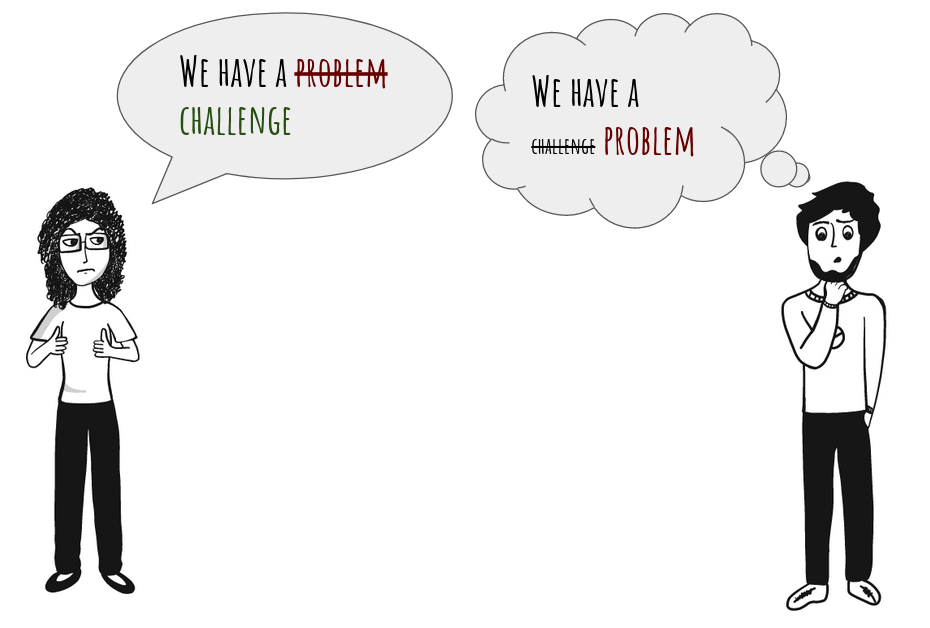“Hey, we are not supposed to say “problem”; it’s a challenge!”. I heard these words so often in my career. “We are positive thinkers here”.
No, you are not. This shallow model of positive thinking damages your performance and limits your success while leaving you emotionally drained.
It took me blood, sweat, and tears to make the damage done by “cargo cult positive thinking” visible and fix it to introduce positive thinking that changes results for the better.
TL;DR version:
- Yes, you need positive thinking
- No, the shallow “thought substitution” positive thinking doesn’t work, moreover it’s harmful
- You need to work to make it work.
What coaches tell you positive thinking is
You probably had corporate training on positive thinking at least once, or at least seen it advertised online. An energetic coach wearing a sales smile welcomed you to the wonderful world of positive thinking where adopting the right vocabulary can suddenly solve all your problems (or challenges).
They could tell you that positive thinking is:
- “The process of creating thoughts that create and transform energy into reality.”
- “The idea that you can change your life by thinking positively about things.”
- “A mental and emotional attitude that focuses on the bright side of life and expects positive results.”
(Spoiler alert: there is some truth in these definitions, but you don’t get to learn it in your company training).
However, in practice, they reduce positive thinking at the workplace to a set of mechanical actions and ceremonies, which have the same effect as building a replica of an airplane in expectation of a cargo airdrop.
Mostly the practical part involves the adoption of a magical vocabulary of a true positive thinker. Here are a few things they will put in the vocabulary:
| Don’t say | Instead say |
|---|---|
| Problem | Challenge |
| Impossible | Challenging |
| I can’t | I can |
| I won’t | I will |
| Failure | Opportunity for improvement |
And many other word pairs like that.
Note: Some coaches recommend positive affirmations, such as “I am a lovable person!” or “My life is filled with joy!”. As a professional manager with 15+ years of experience in leading successful teams, I strongly advise against using these as a workplace practice. Using positive affirmations outside of the workplace goes beyond my expertise, but some experts consider the practice harmful for personal health.
Here are a few examples of how the coaches suggest applying positive thinking in practice.

Working with tight deadlines requires good hard skills, experience, understanding of the work context (e.g. where the deadline comes from), understanding the scope of work, and many other things. Tight deadlines are not opportunities to “test yourself”, and adopting this attitude will be harmful both for you (what if the test does not go well) and for your company who needs the work done.

If you really can’t do something, let your stakeholders know that you can’t. There’s nothing wrong with not being able to do everything.
For example, tricking yourself into thinking you can pull one week’s worth of work in one day will cause the following:
- The quality of the work will not be good.
- In the short term, your managers and stakeholders will be happy.
- In the long term, your managers and stakeholders will be unhappy because the time saving will not compensate for the quality loss.
- If you continue like this, you will be unhappy all the time, and you must repeat the magic mantras louder and louder to silence the negative thoughts.
As a final result, your company will lose a good employee, and you will end up in the doctor’s office suffering from burn-out. Don’t do this. If you can’t make it happen, tell your manager and find ways to be realistic and viable to deliver all work and of good quality.
Acknowledging the issue, asking for help, and finding how to continue is true positive thinking. Saying “I can” when you can’t is a sure way to harm yourself and your organization.
Why shallow positive thinking causes harm
When you teach your employees to use the “word substitution” and “thought substitution” positive thinking, you expect that the process goes like this:

What happens, in reality, is when your trained employee Alice encounters a problem next time, she will correct herself by using the word “Challenge” (so far so good?). Bob, on the other end of the conversation, will translate it back to understand what Alice meant.

Over time, Alice and Bob will learn what the words “really” mean. The next time they meet a real genuine good and interesting challenge, they will think of it as a problem.
I’ve seen it time and again. It always happens. And when it does, it’s extremely difficult to spot it, because your meeting rooms will be filled with positive words, there will be “challenges”, “opportunities for improvement”, and “we can do it”s. A perfect straw airplane, the only challenge sof which is that it does not fly.
True positive thinking and how you can fix it
Positive thinking cannot be based on self-deception or magic rituals. Instead, the focus for your people should be:
“Always look for ways to get as much value as you can from any negative or difficult situation you end up in”.
It sounds more like an opportunistic, even sometimes a selfish way of thinking and certainly should never be taken to the extreme.
However, the key is:
- To acknowledge problems or difficult situations. Do not trick yourself into thinking that difficulties don’t exist.
- To search for the opportunity that lies in that situation.
- To take action.
Searching for a valid opportunity can be difficult, especially for people exposed to false positive thinking before.
Let’s see how this works using an example. Suppose you broke your leg and can’t work for three weeks. Here are bad positive thinking ideas:
| Idea | Remarks |
| “Everything is going well; breaking a leg is awesome!”. |
Usually, breaking your leg is not a good experience and also creates some additional (and sometimes unpleasant) questions for you to solve, such as:
|
| “Breaking a leg is an opportunity for improving my leg’s health!” | This thought makes little sense. However, I saw the same thought so often, for example, in employee performance management.
No, healing your leg is a necessary fix for the consequences of trauma, not an opportunity for improvement. |
| “Having my leg broken is a challenge I’ve been waiting for. It’s a true way to test my character.” | Although technically it _may_ be a challenge to test your character, thinking like that may lead to frustration and suffering. Breaking a leg is not desirable, and you probably would not choose it voluntarily.
It’s an accident that happened, and you will deal with that accident’s consequences in the best way possible. |
And here is a good idea of a true positive thinker:
Now that my leg needs healing, I must stay home. I can’t work, but I can use this time for reading. Let me start with this book that will help me to improve my professional skills.
Note the structure of a good positive thought:
- Acknowledgement of the situation
- Opportunity
- Action
You must stay at home for the following three weeks, and there’s nothing you can do about it (acknowledgement). Find how to make the best use of the time you got, for example, reading a book, doing some easy work in the house, or learning a new skill (opportunity). Take the first steps, for example, order a new book from a bookstore (action).
Conclusion
Substituting words or substituting thoughts is not positive thinking. Instead of seeing more opportunities, your team will learn helplessness after they discover that the magic did not work as they hoped. Shallow positive thinking is harmful both for an individual and a company and can have a long-lasting negative effect on the whole team’s performance.
True positive thinking requires honesty to acknowledge difficulties and work to identify opportunities for improvement and to take action. Only by going through this process you can expect tangible positive results in your organization.
